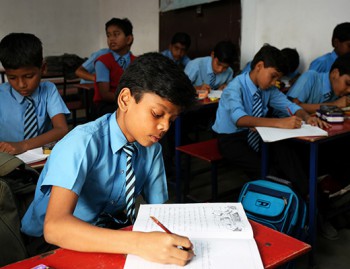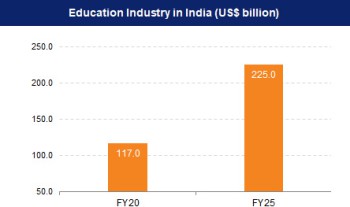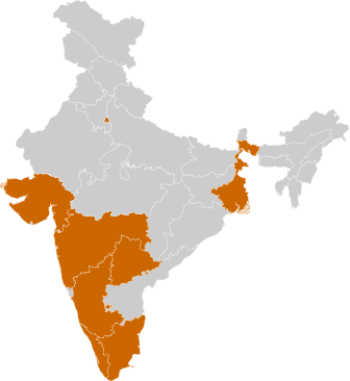INTRODUCTION
India holds an important place in the global education industry. India has one of the largest networks of higher education institutions in the world. However, there is still a lot of potential for further development and improvement in the education system.
With almost 27% of India’s population in the age group of 0-14 years, India’s education sector provides numerous opportunities for growth.

MARKET SIZE

India has the world’s largest population in the age bracket of 5-24 years of about 500 million people, which provides a great growth opportunity for the education sector. The education sector in India was estimated to be worth US$ 117 billion in FY20 and is expected to reach US$ 225 billion by FY25.
India has over 250 million school-going students, more than any other country.
Number of colleges in India reached 42,343 in FY20. As of May 17, 2021, the number of universities in India stood at 981.
In 2021-22, as of February 2022, there are 8,997 total AICTE approved institutes in India. Out of these 8,997 institutes, there were 3,627 undergraduate, 4,790 postgraduate and 3,994 diploma institutes.
ICAR is one of the largest national agricultural organisations in the world. It has 122 institutes and 67 agricultural universities across India, as of July 2021.
India had 38.5 million students enrolled in higher education in 2019-20, with 19.6 million male and 18.9 million female students.
In FY20, Gross Enrolment Ratio (GER) in Indian higher education was 27.1%.
According to UNESCO’s ‘State of the Education Report for India 2021’, the Pupil Teacher Ratio (PTR) at senior secondary schools is 47:1 as against 26:1 of the overall school system.
The Indian edtech market size is expected to reach US$ 30 billion by 2031, from US$ 700-800 million in 2021.
According to KPMG, India has also become the second largest market for E-learning after the US.
The online education market in India is expected to grow by US$ 2.28 billion during 2021-2025, growing at a CAGR of almost 20%. The market grew by 19.02% in India in 2021.
INVESTMENTS
From April 2000-September 2021, Foreign Direct Investment (FDI) equity inflows stood at US$ 6.74 billion according to the data released by Department for Promotion of Industry and Internal Trade (DPIIT).
The education and training sector in India witnessed some major investments and developments in the recent past. Some of them are:
- India has 89 universities in Times Higher Education Emerging Economies University Rankings 2022, behind Russia with 100 and China with 97.
- A total of 71 Indian institutions have been qualified for the Times Higher Education World University Rankings 2022, up from 63 in 2020.
- As per the QS employability rankings 2022, the Indian Institute of Science (IISc), Bengaluru, six Indian Institutes of Technology (IITs), Delhi University, University of Mumbai, University of Calcutta, OP Jindal Global University, Sonipat and BITS Pilani were among the global top 500 universities.
- Indian edtech startups have received total investment of US$ 4.7 billion in 2021, up from US$ 2.2 billion in 2020.
- The edtech space has attracted private equity investments of over US$ 4 billion over the last five years.
- In February 2022, the AICTE - backed by AWS Academy and EduSkills - launched a two-month virtual internship program in AI for 5000 students. The course duration is two months and the students will receive a certificate and a digital badge upon completion.
- In February 2022, education-focused fintech firm Propelld raised US$ 35 million from in a series-B funding round from WestBridge Capital, Stellaris Venture Partners, India Quotient and others.
- In February 2022, the Tech Mahindra Foundation, the company's CSR arm, has partnered with Amazon Internet Services Private Limited (AISPL) to help underemployed or unemployed people get started in cloud computing. The AWS re/Start programme is a 12-week in-person skills-based training programme that covers foundational AWS Cloud abilities, as well as practical job skills like interviewing and resume writing to assist individuals prepare for entry-level cloud positions.
- In October 2021, Teachmint was valued at US$ 500 million after a US$ 78 million funding round.
- In October 2021, Byju’s raised Rs. 2,200 crore (US$ 300 million) to increase the company’s valuation from US$ 16.4 billion in 2020 to US$ 18 billion in 2021.
- In September 2021, Amazon launched its global computer science education initiative in India. The aim of this initiative is to offer one lakh students the opportunity to study computer science.
- In September 2021, Eupheus Learning, a New Delhi-based B2B edtech startup, raised US$ 10 million from private equity platform Lightrock India in a Series C funding round.
- In September 2021, online tutoring platform Vedantu achieved unicorn status as the company raised US$ 100 million in a Series-E funding round led by Singapore-based ABC World Asia.
- In September 2021, Gradeup, one of India's leading online exam preparation platforms, was acquired by BYJU's, the world's most-valued edtech firm.
- In September 2021, edtech firm 88academics announced that it raised equity financing of Rs. 22.1 crore (US$ 3 million) in funding led by Aarin Capital Partners.
- In August 2021, Indian online learning platform Unacademy raised US$ 440 million in a financing round led by Temasek, which valued the six-year old startup at US$ 3.44 billion.
- In August 2021, Harappa, a homegrown EdTech firm and India's foremost online institution for behavioural learning, hosted Bridge, a landmark annual and multi-format online event that brought together education and industry leaders for the first-time on the same platform.
- In June 2021, Amazon India launched a Machine Learning Summer School to help students learn new skills.
GOVERNMENT INITIATIVES
Some of the other major initiatives taken by the Government are:
- 100% FDI under automatic route is allowed in the Indian education sector.
- To liberalise the sector, the Government has taken initiatives such as the National Accreditation Regulatory Authority Bill for Higher Educational and the Foreign Educational Institutions Bill.
- The government schemes of Revitalising Infrastructure and System in Education (RISE) and Education Quality Upgradation and Inclusion Programme (EQUIP) are helping the government tackle the prominent challenges faced by the education sector.
- As per the Union Budget 2022-23, allocation towards the Samagra Shiksha Scheme has increased by around 20.3%, from Rs 31,050.16 crore (US$ 4.16 billion) in FY22 to Rs 37,383.36 crore (US$ 5.01 billion) in FY23.
- In February 2022, the central government approved the “New India Literacy Programme” for the period FY 2022-27 to cover all the aspects of adult education to align with National Education Policy 2020 and Budget Announcements 2022-23.
- In February 2022, the Ministry of Education approved the scheme of Rashtriya Uchchatar Shiksha Abhiyan (RUSA) to continue till 2026.
- National Education Policy (NEP) 2020 emphasis on early childhood care and education. The 10+2 structure of school curricula is to be replaced by a 5+3+3+4 curricular structure corresponding to ages 3-8, 8-11, 11-14, and 14-18 year, respectively.
- The Cabinet accepted the continuance of the Samagra Shiksha School Education Scheme in 2021 from April 1, 2021, to March 31, 2026.
- In October 2021, the NSDC launched the largest 'Impact Bond' in India, with a US$ 14.4 million fund, to help 50,000 youngsters in the country acquire skills necessary for employment.
- In September 2021, the ATL Space Challenge 2021 was launched by the Atal Innovation Mission (AIM) in cooperation with the Indian Space Research Organisation (ISRO) and the Central Board of Secondary Education (CBSE) for all school students in India.
- In September 2021, The National Commission for Women started a country-wide capacity building and personality development programme for women undergraduate and postgraduate students in an effort to make them more independent and job-ready. The commission will partner with central and state institutions to prepare women students for the job market by providing sessions on personal capacity building, professional career skills, digital literacy and effective use of social media.
- STEM-based edtech companies are partnering with Niti Aayog and the government to build a STEM ecosystem by establishing Atal Tinkering Labs (ATL) to spread knowledge about STEM, STEAM, AI, ML, AND Robotics for K-12 students.
- On September 17, 2021, Mr. Ashwini Vaishnaw, the Minister of Railways, Communications, Electronics and Information Technology, launched Rail Kaushal Vikas Yojana, a programme under Pradhan Mantri Kaushal Vikas Yojana (PMKVY), to empower youth by providing entry-level training in industry relevant skills through railway training institutes.
- In September 2021, NITI Aayog announced a collaboration with BYJU’s. In this partnership, students in government schools in 112 ‘aspirational districts’ will have free access to the company's ‘quality learning materials’. BYJU'S will also give free engineering and medical entrance test preparation sessions to 3,000 deserving students in Classes 11 and 12 through Aakash Institute.
ROAD AHEAD
In 2030, it is estimated that India’s higher education will:
- Combine training methods that involve online learning and games, and is expected to grow by 38% in the next 2-4 years.
- Adopt transformative and innovative approaches in higher education.
- Have an augmented Gross Enrolment Ratio (GER) of 50%.
- Reduce state-wise, gender based and social disparity in GER to 5%
- Emerge as the single largest provider of global talent with one in four graduates in the world being a product of the Indian higher education system
- Be among the top five countries in the world in terms of research output with an annual R&D spend of US$ 140 billion
- Have more than 20 universities among the global top 200 universities

Various Government initiatives are being adopted to boost the growth of distance education market besides focusing on new education techniques, such as E-learning and M-learning.
Education sector has seen a host of reform and improved financial outlays in recent years that could possibly transform the country into a knowledge haven. With human resource increasingly gaining significance in the overall development of the country, development of education infrastructure is expected to remain the key focus in the current decade. In this scenario, infrastructure investment in the education sector is likely to see a considerable increase in the current decade
The Government of India has taken several steps including opening of IIT’s and IIM’s in new locations as well as allocating educational grant for research scholars in most Government institutions. Furthermore, with online mode of education being used by several educational organisations, the higher education sector in India is set for major change and development in the years to come.
Note: Conversion rate used for February 2022 is Rs. 1 = US$ 0.013
References:Media Reports, Press Releases, Press Information Bureau, RNCOS Report, Department for Promotion of Industry and Internal Trade (DPIIT), Union Budget 2021-22
Disclaimer:This information has been collected through secondary research and IBEF is not responsible for any errors in the same
Top Indian cities for Education
- Bangalore
- Mumbai
- New Delhi
- Hyderabad
- Chennai
- Manipal
- Kolkata
- Pune
- Kochi
- Ahmedabad

Industry Contacts
- University Grants Commission (UGC)
- All India Council of Technical Edcuation(AICTE)